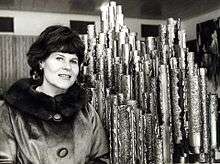Eila Hiltunen
Eila Vilhelmina Hiltunen (22 November 1922, Sortavala – 10 October 2003, Helsinki) was a Finnish sculptor. She is most famous for the Sibelius Monument (1967). A statue by Hiltunen resembling a smaller version of the Sibelius Monument stands on the grounds of the United Nations headquarters in New York City.
Eila Hiltunen | |
|---|---|
 Hiltunen with a miniature version of the Sibelius sculpture in 1965. | |
| Born | 22 November 1922 |
| Died | 10 November 2003 |
| Nationality | Finland |
| Occupation | Sculptor |
| Spouse(s) | Otso Pietinen |
Life
Hiltunen was born into a prosperous family in 1922. Her father invested in automobiles and her mother was a strong supporter of her only child. The family's prospects changed dramatically during the economic crash of 1929 and her father took to drink. He died in 1941 and it was her mother who brought her up. Hiltunen's artistic ambitions were empowered at the Finnish Art Academy where she won the prize for sculpture twice.[1]
She married in 1944 and had children.[1] She and her sometimes violent husband had a difficult relationship.[2] She always used her birth name. Their marriage lasted 50 years until Otso Pietinen's death although they were not always together.
Hiltunen is most famous for the Sibelius Monument which was constructed in 1967. The sculpture won a competition organised by the Sibelius Society following the composer's death in 1957.
Although her abstract sculpture of pipes is now well regarded as an important Finnish landmark, its initial reception was controversial. The objection centred on the abstract design; and although the design looked like stylised organ pipes, it was known that the composer had created little music for organs. To address her critics' concern, she was required to add Sibelius's face beside the main sculpture.[3] A sculpture by Hiltunen resembling a smaller Sibelius Monument stands in the grounds of the United Nations headquarters in New York City.
Hiltunen was awarded the Finland Prize in 2000. Her husband, Otso Pietinen, died in 1997, and Hiltunen died in 2003.[2]
References
- Eila Hiltunen at Eilahiltunen.net, Retrieved 20 March 2016
- NEW Book of cruel truths of the top artists of marriage, 12 September 2012, MTV.fi, Retrieved 20 March 2016
- Grimley, Daniel M. (8 August 2011). Jean Sibelius and His World. Princeton University Press. pp. vii, 338 and 353. ISBN 1-4008-4020-1.
External links
| Wikimedia Commons has media related to Eila Hiltunen. |